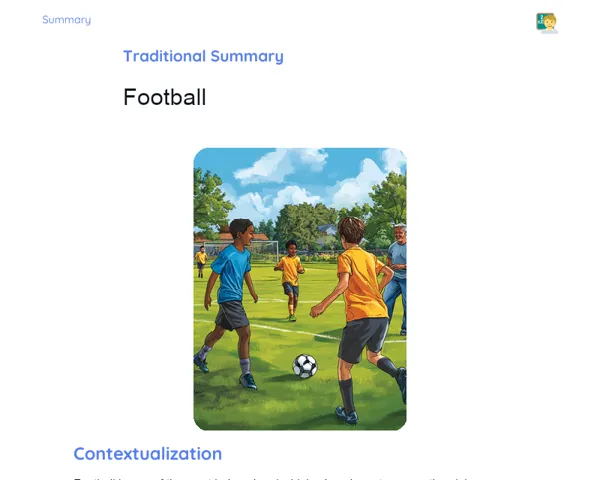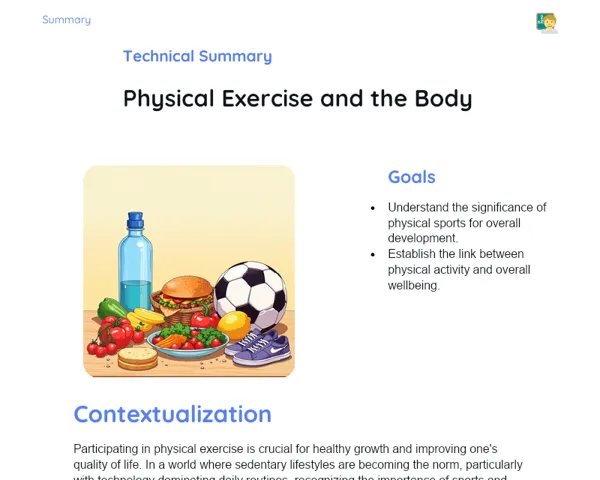Summary Tradisional | Handball: Introduction
Contextualization
Handball is an energetic and engaging team sport involving two teams of seven players each, including a goalkeeper. It originated in Europe during the late 19th century and quickly became popular across the globe for its blend of speed, strategy, and skill. This sport demands physical stamina, coordination, and teamwork, making it an excellent medium for enhancing motor and social skills among students.
Known to be one of the fastest sports around, handball sees the ball reaching speeds of up to 100 km/h in professional matches. It made its Olympic debut as a demonstration sport in Berlin in 1936 and became a staple in the official program in Munich in 1972. These details underscore handball's significance and influence on the global sports arena.
To Remember!
Basic Rules of Handball
Handball is played between two teams of seven players, including one goalkeeper. Each match consists of two halves of 30 minutes with a 10-minute half-time break. The goal is to score more goals than the opposing team by throwing the ball into their goal. Players can take three steps while holding the ball before they must either dribble or pass. They are allowed to hold the ball for a maximum of three seconds without moving.
Common fouls include 'traveling' (taking more than three steps without dribbling), 'goal area violation' (a player entering the goalkeeper's area), and various fouls related to attacking or defending, which may lead to free throws or temporary exclusions from the game. The goalkeeper's area is off-limits to other players, and they can use any part of their body to block shots on goal.
Each goal counts for one point, and the team with the highest score at the end of the match wins. In the event of a tie, extensions or penalty shootouts might take place based on the tournament's regulations.
-
Teams of seven players, including a goalkeeper.
-
Two halves of 30 minutes with a 10-minute break.
-
Movement rules: up to three steps and three seconds with the ball.
-
Common fouls: traveling, goal area violation, and attack/defense fouls.
-
Each goal is worth one point.
Characteristics of the Game
Handball is a highly dynamic sport that requires considerable physical stamina and quick decision-making skills. The fast-paced nature of the game is marked by rapid shifts between offense and defense. Success in handball demands the capability to run, jump, and throw the ball with precision.
Teamwork is crucial in handball. Effective coordination and communication among players are needed to create scoring opportunities and establish a solid defense. Each player holds a specific role, and the synergy within the team plays a pivotal role in achieving success. Tactical strategies like set plays and defensive formations are constantly employed to outmaneuver opponents.
The sport places a high demand on physical endurance, requiring players to sustain a high pace throughout the match, which necessitates robust physical conditioning. Additionally, quick reflexes and the ability to execute rapid, accurate movements are essential skills for handball players.
-
Dynamic and high-speed game.
-
Importance of teamwork and effective communication.
-
Need for physical endurance and excellent motor coordination.
Technical Fundamentals
The technical foundations of handball encompass skills such as passing, dribbling, shooting, and defending. Passing is vital for ball movement among players and can be executed in various forms, like chest passes, overhead passes, or bounce passes. Timely and accurate passing is crucial for maintaining possession and generating scoring chances.
Dribbling enables players to advance the ball while evading defenders. Although limited compared to some other sports, dribbling in handball allows players to bounce the ball while moving. Quick dribbling and agility in changing direction provide a key advantage.
Shooting remains the main method of scoring in handball. Diverse shot types—like jump shots, standing shots, and spin shots—require strength and accuracy to successfully bypass the goalkeeper. Defending is a combination of the goalkeeper's skills and the overall organization of the defensive setup, aimed at intercepting passes and obstructing shots.
-
Passing: precision and quickness are essential.
-
Dribbling: skill to navigate past defenders.
-
Shooting: strength and accuracy for scoring.
-
Defending: teamwork and skill to intercept plays.
Major Championships
Handball boasts several key championships across the globe. The Handball World Championship, organized by the International Handball Federation (IHF), stands as one of the most prestigious tournaments, held every two years for both men and women. This championship showcases top national teams from around the world and highlights international talent.
Another important event is the EHF Champions League, which serves as the premier club competition for handball in Europe. Clubs from across the continent vie for the title of best European team, known for its competitive spirit and high technical standards.
The Olympic Games are also a significant occasion for handball. Since its official inclusion in 1972, it has formed an integral part of the Games, with countries worldwide competing for Olympic glory. Furthermore, continental championships and national leagues play a vital role in the promotion and growth of handball.
-
Handball World Championship: Hosted by the IHF.
-
EHF Champions League: Leading club competition in Europe.
-
Olympic Games: Esteemed event since 1972.
-
Continental championships and national leagues.
Key Terms
-
Basic Rules: Guidelines that govern the game.
-
Game Characteristics: Physical and tactical aspects of handball.
-
Technical Fundamentals: Key skills including passing, dribbling, shooting, and defending.
-
Major Championships: Significant tournaments like the World Championship, EHF Champions League, and Olympic Games.
-
History of Handball: Evolution and background of the sport.
-
Teamwork: Coordination and collaboration among players.
-
Physical Endurance: Capability to maintain high energy levels during the match.
Important Conclusions
In this lesson, we delved into handball, an energetic and engaging team sport. We covered the basic rules, such as team composition, match duration, and notable fouls. Additionally, we highlighted the defining characteristics of the game—emphasizing the vital roles of speed, teamwork, and physical stamina.
We examined the technical fundamentals, including essential skills of passing, dribbling, shooting, and defending, critical for effective performance. Moreover, we learned about major championships like the World Championship, EHF Champions League, and Olympic Games, recognizing handball's historical significance on the global stage.
Through this lesson, students were motivated to cultivate their motor and social skills and comprehend the relevance of handball in both sports and cultural education. It’s important for them to continue exploring this topic to deepen their understanding and appreciation of this captivating sport.
Study Tips
-
Review the illustrative videos used in class to reinforce your understanding of handball's technical fundamentals.
-
Delve into the history and rules of handball from trustworthy resources like the International Handball Federation (IHF) website.
-
Watch live handball matches, particularly from major championships, to see rules and strategies in action.



